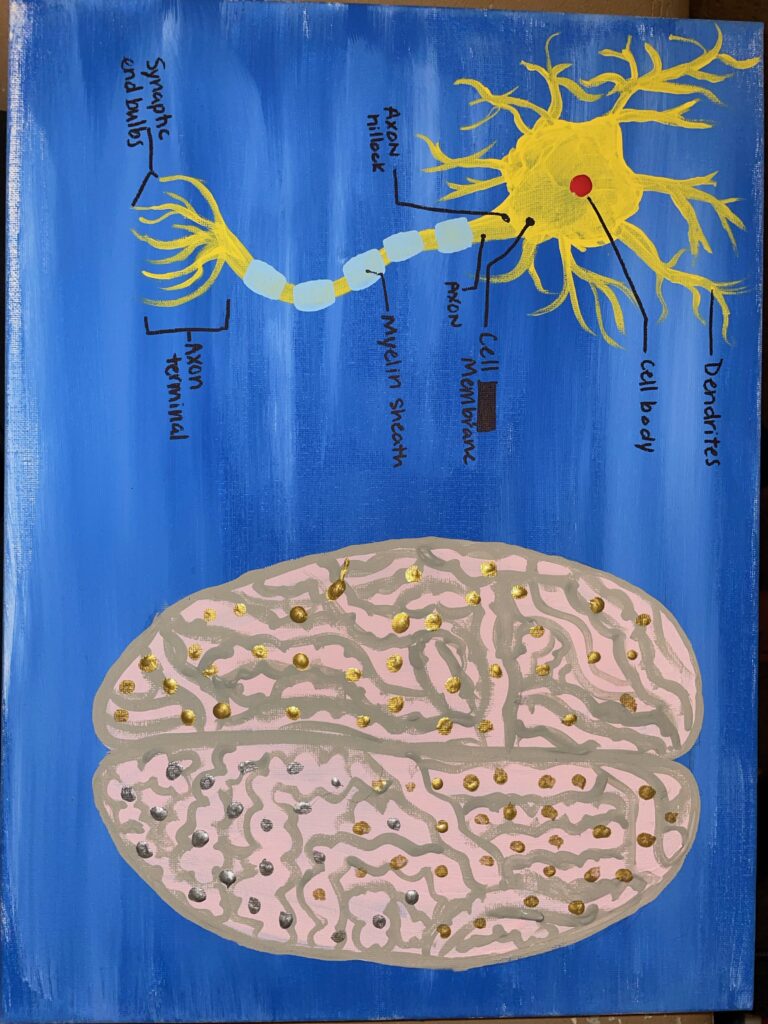Without our nervous system our bodies would be just short of nothing, unable to properly communicate within itself and in turn we would be unable to create all the movements that make us. The nervous system is our body’s system of controlling and communicating within itself. Our cells are using small electrical impulses to communicate with each other to take in the world around us and be able to respond to it accordingly, and sometimes not. My objective that I have chosen to focus on is explaining how neurons carry an electrical charge, and my topic of choice is that in relation to epilepsy. Explaining how something seemingly so small can unravel the intricacies of our body, how it communicates, and how it reacts to anything and everything.
As previously mentioned, this all pertains to our nervous system, and the structural units that make up our nervous system are neurons. Neurons are large, highly specialized cells that conduct these electrical impulses as a form of communication. They are made up of the nucleus, which is held in the cell body with dendrites on the outskirts of said cell body, the axon with the myelin sheaths as protection for the pathway to the terminal branches and finally the synapse. They are able to conduct these electrical changes through action potential and resting potential, this is due to the action potential and resting potential and how they direct the flow of ions through the cell’s plasma membrane. The action potential carrying the information from one to another. The electrical charge is entered through one cell through the dendrites, travels down the axon, with the myelin sheaths aiding in the speed and protection of which the signal travels, going through the terminal branches, and zapped to the next cell through the synapse. Epilepsy is the disruption of this process and in turn causes our bodies to react in uncontrolled frenzy.
Autoimmune epilepsy is viewed as an autoimmune disorder in effort to explain the phenomenon of why the brain would be causing recurring and seemingly unprovoked seizures. This led to studies and theories of the antibodies that work in relation with these electrical signals and cause disruption of this carefully crafted system of communication. The following link will lead you to a table listing some of these antibodies and the relationship between them and the communication of the nervous system, https://www.ncbi.nlm.nih.gov/pmc/articles/PMC8790247/table/T1/?report=objectonly.
As stated above the synapse is what propels the action potential, carrying the information, to the next cell, relaying the message throughout the body until it reaches its destination. Some of these antibodies, such as GluR3B peptide antibodies affect the synapse and in turn stop the action potential in its track. Essentially dropping this electrical charge of information. In simple terms, it’s like a glitch where your laptop freezes and then the page looks like it’s spazzing out on you in a blur of shaking, barely able to read the words. In humans, this is the seizure that is prevalent as a symptom of epilepsy.
The intricacy involved with our bodies’ way of communication is why it is so difficult for doctors to treat epilepsy. It’s not as easy as replacing a light bulb in the lights of our Christmas trees to have the other half of the lights flicker back to life. Rather the NASA crew identifying all the stars, planets, and galaxies and attempting to figure out just how vast space is and how we are connected to it, somehow in the perfect spot with conditions for us to sustain life.
References
Brodie, Martin J, et al. “Epilepsy, Antiepileptic Drugs, and Aggression: An Evidence-Based Review.” Pharmacological Reviews, U.S. National Library of Medicine, July 2016, https://www.ncbi.nlm.nih.gov/pmc/articles/PMC4931873/.
Electrical Signals of Nerve Cells – Neuroscience – NCBI Bookshelf. https://www.ncbi.nlm.nih.gov/books/NBK11053/.
Farrokh, Salia, et al. “Antiepileptic Drugs in Critically Ill Patients.” Critical Care (London, England), U.S. National Library of Medicine, 7 June 2018, https://www.ncbi.nlm.nih.gov/pmc/articles/PMC5992651/.
Levite, Mia, and Hadassa Goldberg. “Autoimmune Epilepsy – Novel Multidisciplinary Analysis, Discoveries and Insights.” Frontiers in Immunology, U.S. National Library of Medicine, 12 Jan. 2022, https://www.ncbi.nlm.nih.gov/pmc/articles/PMC8790247/.


I think you did very good at showing your objective of explaining how neurons carry an electrical charge. I love the creativity with the art work showing the loss of the electrical charge in the brain and the picture of the cell process. Honestly I thought epilepsy was something totally different so I appreciate the lesson about it. I think it is very sad that the doctors do not know exactly what causes it and how to treat it. You did a good job of explaining how neurons carry an electrical charge. I really liked your closing comment about the Nasa Crew identifying all the stars and planets in the sky. That statement is a great likeness of the Neurons in our bodies. You also did a good job explaining the process of an electrical charge from start to finish. This is a clearly written statement. The information is accurate and it makes me want to learn more about it. The grammar is good and easy to read. You speak through your own voice about the subject. It shows that you spent your time on it. I would give you an extra 10 out of 10 points on your project.